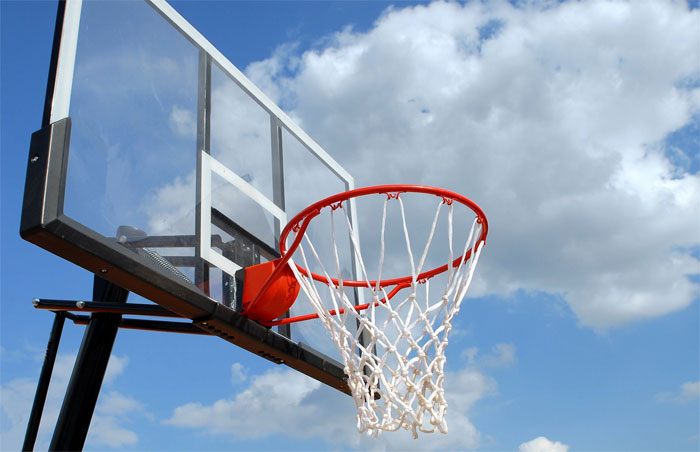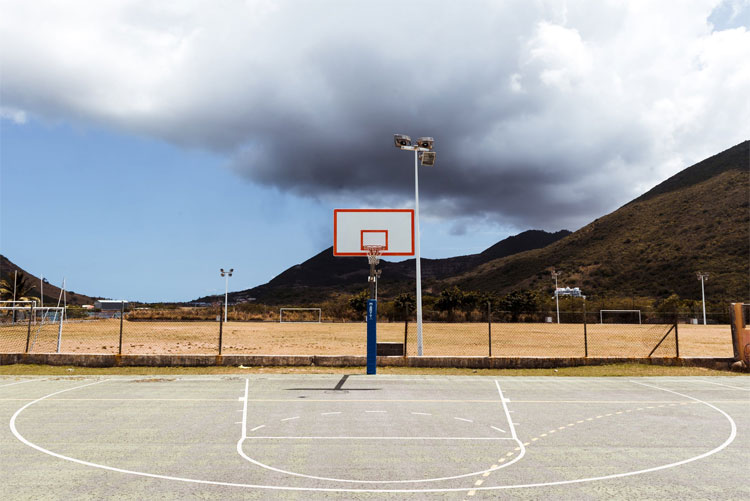Are you interested in setting up a basketball court, complete with a score-keeping board, but don't know where to start? Then you are in the right place.
In this article, we will cover the pros and cons of polycarbonate vs. acrylic backboards. These are the two most popular backboard materials, and we will explain some key factors that will help you decide which type is right for you.
We will also cover the three different mounting styles available and average prices on the market. If you want to learn more about basketball backboards, read on.
Polycarbonate Basketball Backboards
When considering the polycarbonate vs. acrylic backboard differences, polycarbonate seems the more robust and more durable option of the two materials.
However, this is not always the case. The factor that has the most impact on the material's durability is whether it is for indoor or outdoor use.
When a polycarbonate board gets exposed to UV light rays, such as those from the sun, the material will begin deteriorating fairly quickly.
The transparent material will become cloudy and take on a yellow hue. UV light rays will also soften the material, making it brittle and far more likely to crack.
Because of the adverse effects of the UV rays, polycarbonate is not an ideal backboard material if you are planning to use it outdoors. Not only will it quickly become aesthetically unappealing, but it will lose its durability.
With daily exposure to UV light, these effects will typically build over a three to five-year period.
All this said, when these boards do not get UV lighting exposure, they can have up to five times the strength and durability of a traditional acrylic board.
Because of this, if you will be using the backboard on an indoor court only, polycarbonate is the best option. Without the damage caused by UV lighting, this material will withstand excessive dunking and overshot throws.
Acrylic Basketball Backboards
High-quality acrylic backboards are one of the most popular options for an outdoor basketball court. Unlike the effect on polycarbonate, UV lighting does not deteriorate acrylic backboards.
The material can stay in the sun for weeks, months, and years without seeing a change from the UV rays. Its strength and durability will remain unaffected, and it will be as sturdy as the day you installed it.

In general, this is a very sturdy material. It can withstand high levels of blunt force impact without smashing or cracking.
Because of this, if you hit your backboard directly with the ball, it will not snap, crack, or shatter in the way that glass could.
One crucial difference between a polycarbonate vs. acrylic backboard is that acrylic is a much more lightweight material.
Some people consider this negative, as they are looking to see a strong bounce when they hit the backboard with the ball.
Since this material weighs so much less, you won't encounter the same levels of spring and bounce back that you would from a solid polycarbonate backboard.
Even with the effects of the lightweight material, the durability and longevity that it offers make it an ideal option for an outdoor basketball court.
This material is also ideal in an outdoor setting since it does not become weak from exposure to UV light.
Average Prices for Polycarbonate vs. Acrylic Backboard
Overall, the price ranges of polycarbonate vs. acrylic backboards are relatively similar.
And when shopping for a new basketball backboard, there are three main styles to choose from: wall-mounted, portable, and in-ground.
Aside from brand quality, the most significant factor that will affect the price of the backboard will be the size. Professional NBA games use backboards that are 72", and these are the largest available for purchase.
However, if you are working with a smaller space and want something that is a bit more appropriately sized, there are many options available between 45" and 60". These smaller options are also far more affordable.
Wall-Mounted
When considering a wall-mounted style, it is crucial to think about your hoop's surroundings. Make sure that the wall you intend to mount the backboard onto has strong structural integrity.
This style is popular for mounting outside a garage or on another exterior wall of your home. Wall-mounted hoops can offer a lot of stability, although they will typically need to be at a fixed height.

If you are looking for a smaller backboard between 44" and 54" for personal use, the price between materials is reasonably comparable. Acrylic boards tend to run between $200-$500, and polycarbonate boards cost between $100-$500.
If you are looking for a high-quality adjustable acrylic backboard or one that is 72", they can cost more than $1,000. This size is generally not available in polycarbonate, as most wall-mounted units in this size are usually acrylic or tempered glass.
Portable
Portable basketball hoops are stand-alone fixtures with wheels that allow for easy movement to adjust to your space.
The bases of these hoops typically get weighed down with water or sand to prevent them from moving during the game. The height of these hoop's backboards is adjustable, making them an excellent option for young players who are still growing.

For a portable set between 44" and 54", you can find acrylic models between $150-$700 and polycarbonate models between $250-$500.
A professional-sized 72" portable acrylic set will generally range between $500-$2,000. Unfortunately, you won't find a 72" portable backboard hoop made from polycarbonate.
In-Ground
This type of basketball hoop gets secured in the ground with cement, so you won't need to worry about it tipping over.
They are an excellent option for outdoor community basketball courts or families planning for a long-term basketball setup for their home. The height of these hoops is adjustable, so they can accommodate players of many ages and skill levels.

If you want a 44" and 54" basketball hoop that secures into the ground, most acrylic boards will cost between $100-$350. Polycarbonate models are very similar, running between $150-$300.
For a 72" regulation-sized board, an acrylic model can cost between $800-$3,000. The polycarbonate models can also run between $1,000-$2,500.
Final Thoughts: Polycarbonate vs. Acrylic Backboard
When comparing both types of backboards, there are many strengths for each of the materials.
While polycarbonate tends to be more robust and more durable than acrylic, this is generally only the case for basketball courts not exposed to UV light.
If you are looking for a new backboard for your outdoor basketball court, we recommend choosing an acrylic model. They won't get damaged by UV rays, and they can sustain durability without staining and cracking.
However, if you are shopping for an indoor court, they are equally strong materials.
You might also like: Best Tempered Glass Basketball Hoop
